+ Event synopsis - Kellogg Innovation Network
+ Event synopsis - Kellogg Innovation Network
+ Event synopsis - Kellogg Innovation Network
You also want an ePaper? Increase the reach of your titles
YUMPU automatically turns print PDFs into web optimized ePapers that Google loves.
MANAGING THROUGH UNCERTAINTY. MASTERING NEW REALITIES.<br />
<strong>Kellogg</strong> <strong>Innovation</strong> <strong>Network</strong> (KIN) Dialogue: Fall 2009<br />
James L. Allen Center<br />
Evanston, Illinois<br />
November 9-10, 2009<br />
Pictured from left to right: Jørn Bang Andersen, Nordic Council of Ministers; Thomas Barnett,<br />
Geopolitical Consultant to the Pentagon & White House and New York Times Bestselling Author, Great<br />
Powers: America and the World After Bush; Polly Flinn, VP, Global Marketing, BP; Paul Epner, Principal,<br />
Paul Epner LLC; Alan Landry, Director of Business Development, Land Combat Systems, Raytheon<br />
Missile Systems; Robert C. Wolcott, Executive Director, KIN; Nelson Levy, Founder & CEO, CoreTechs;<br />
Phil Kotler, Professor, <strong>Kellogg</strong> School of Management.<br />
DIALOGUE HOST:<br />
Robert C. Wolcott, Ph.D.<br />
Executive Director<br />
<strong>Kellogg</strong> <strong>Innovation</strong> <strong>Network</strong> (KIN)<br />
r-wolcott@kellogg.northwestern.edu
Managing Through Uncertainty. Mastering New Realities.<br />
<strong>Kellogg</strong> <strong>Innovation</strong> <strong>Network</strong> (KIN) Dialogue<br />
November 9-10, 2009<br />
“Many great companies have been started in downturns—IBM for instance. If my hair is on<br />
fire, and you can put it out, I’ll pay you for it.”<br />
— Matt McCall, Managing Director, New World Ventures<br />
“If you walk into a bar and shoot two guys on either side of a guy, he’s not just going to sit<br />
there. Iran will get a bomb.”<br />
— Dr. Tom Barnett, Geopolitical Consultant to the Pentagon & White House<br />
and New York Times Bestselling Author<br />
“A crisis a terrible thing to waste. How do we take advantage of this event in a nonjudgmental<br />
fashion; that is, not labeling it positive or negative but rather an opportunity?”<br />
— Denis Browne, Senior Vice President, Business Objects, SAP<br />
“Engineering is the ‘art of the possible’ and marketing is the ‘art of the valuable.”<br />
— Robert C. Wolcott, Co-founder of the <strong>Kellogg</strong> <strong>Innovation</strong> <strong>Network</strong><br />
Summary prepared by:<br />
Stephanie Wolcott<br />
Content Director, KIN Global<br />
Contributions by:<br />
Paul Epner<br />
Principal, Paul Epner LLC<br />
Michael J. Lippitz, Ph.D.<br />
KIN Research Fellow<br />
<strong>Kellogg</strong> School of Management, Northwestern University Page 2 of 10
Managing Through Uncertainty. Mastering New Realities.<br />
<strong>Kellogg</strong> <strong>Innovation</strong> <strong>Network</strong> (KIN) Dialogue<br />
November 9-10, 2009<br />
EXECUTIVE SUMMARY<br />
Framing the Conversation<br />
“How do you create strategy in an increasingly uncertain world?” This was the focus of the KIN<br />
Fall Dialogue 2009—a tour-de-force of macro-trends and future visions of global affairs, as well as<br />
down-to-earth insights on personal productivity. We went deep into experiences with leadership<br />
during transformational change and received some strong medicine for corporate turnarounds.<br />
KEY DIALOGUE INSIGHTS<br />
• We are no longer dealing with just predictable cycles but also ‘black swans,’ that is, dramatic<br />
and rapid shifts in the global environment.<br />
• Increased complexity and speed of change has created unprecedented ambiguity.<br />
• In our unpredictable world, it is important to have an Early Warning System to identify risks<br />
and opportunities.<br />
• Scenarios are an important tool to plan for an unpredictable future.<br />
• Don’t manage the rate of failure, manage the cost of failure.<br />
• If given a choice between an innovative product or innovative business model, choose the<br />
business model.<br />
• The KIN is one opportunity to do things outside your normal routine to create unexpected<br />
insight.<br />
KEY QUESTIONS<br />
• How can companies develop sound strategy in an unpredictable world? What structures are<br />
needed?<br />
• What role can business, your business, play in building true prosperity around the world?<br />
• What does the global gap (arc of instability) mean for your company?<br />
• There is a massive opportunity to engage the 2 billion people, truly poor people, at “the base<br />
of the pyramid” in the formal economy, as both consumers and producers. Can your<br />
company develop relevant products and services in healthcare, housing, water, nutrition and<br />
energy for this massive market?<br />
THEMES<br />
• Increased, atomized, and hard-to-predict competition.<br />
• Emergence of the BRIC countries, especially an avid, aspiring middle class.<br />
• <strong>Innovation</strong> driven by growing scarcity of resources.<br />
• Globalization and localization at the same time.<br />
• Greater levels of customization required for increasingly fragmented customer groups.<br />
<strong>Kellogg</strong> School of Management, Northwestern University Page 3 of 10
Managing Through Uncertainty. Mastering New Realities.<br />
<strong>Kellogg</strong> <strong>Innovation</strong> <strong>Network</strong> (KIN) Dialogue<br />
November 9-10, 2009<br />
Monday, November 9, 2009<br />
SESSON 1: PANEL DISCUSSION<br />
Industry Outlooks: Looking to the Future as Everything Changes<br />
“What’s really NEW in the global economic downturn?” This panel discussed whether or not there<br />
are any truly new phenomenon, or if this crisis is more about magnitude.<br />
Panelists<br />
Mark Kipphut, Director, Strategic Planning, Raytheon<br />
There is no more long-term predictability. The new political landscape has forced a 5-year<br />
strategy into 1-year segments. It takes $65 to $75 million and 7-10 years of investment for a midrange<br />
technology. There is a need for new tools to help improve predictability. Adversaries are<br />
not “playing by the rules,” that is, they are not acting like nation-states.<br />
Fabienne Munch, Director, Design Studio, Herman Miller<br />
Competition has become atomized, global and unpredictable. Good has become the new<br />
great; that is, customers are changing what they value, and we need to be careful to not give<br />
them more than they are willing to pay for. This has been accelerated by the downturn. Product<br />
development needs to focus on customer needs, not competitor tactics.<br />
Joe Wheeler, Executive Director, The Service Profit Chain Institute<br />
The depth of cuts in service industries has been enormous, but customers still demand a high level<br />
of service.<br />
Discussion<br />
Phillip Kotler: “What’s the worst and best that can happen? Can we develop an early warning<br />
system to guide effective decision-making?”<br />
Paul Epner: <strong>Event</strong>s are just events. People should spend less time on assigning valence to them<br />
and more time determining their response. There’s no such thing as good weather or bad<br />
weather, just inappropriate clothing.<br />
Nelson Levy/Rob Wolcott: Large companies have the advantage in becoming integrators of<br />
ailing companies with good assets. Small companies lack the depth of resources.<br />
<strong>Kellogg</strong> School of Management, Northwestern University Page 4 of 10
Managing Through Uncertainty. Mastering New Realities.<br />
<strong>Kellogg</strong> <strong>Innovation</strong> <strong>Network</strong> (KIN) Dialogue<br />
November 9-10, 2009<br />
Case Study<br />
Foresight, Insight & Action: Building robust long-term growth strategies<br />
Peter Bryant, President of TransTech and KIN Fellow<br />
The Foresight, Insight and Action process positions a company to take advantage of new<br />
opportunities and mitigate emerging threats. The critical question: What are the forces driving the<br />
key markets you’re in? For example, UPS looks 15 years out. It doesn’t focus on competitors<br />
(FedEx) for long-term strategy but explores what capabilities they may need that no one is<br />
thinking about.<br />
Peter showed an example of scenario planning based on the 2 most impactful uncertainties in<br />
your business and how to create robust options around technology, portfolio, advocacy and<br />
image. Scenario planning is most valuable if focused on possibilities more than 10 years out.<br />
Scenario planners may need to be quarantined from their mainstream colleagues.<br />
SESSION 2: GLOBAL PERSPECTIVE<br />
Dr. Thomas P.M. Barnett<br />
Geopolitical Consultant to the Pentagon & White House<br />
New York Times Bestselling Author, Great Powers: America and the World After Bush<br />
American’s role in the world should be a natural extension of the experience of U.S. history. But<br />
many in the U.S. do not understand how long it took us to become what it is. In the U.S., as well as<br />
in new democracies, single party rule usually lasts about 50 years before a viable multi-party<br />
democracy emerges. The U.S. elected rebel leader (Washington), then hatchet man (Adams),<br />
then ideologue (Jefferson). In 1820 Madison ran unopposed. The U.S. doesn’t develop two mass<br />
political parties until 1840, 64 years later. Andrew Jackson is the first outsider president—he<br />
instigates mass ethnic cleansing (Seminole, Trail of Tears).<br />
In the “old days” there was the Department of War and the Department of Navy. The Navy was<br />
the promoter of U.S. values and protector of freedom of the seas. As a result of the Navy’s early<br />
forays around the world, the U.S. has closer relationships with many Asian countries than they<br />
have with their neighbors.<br />
The U.S. dollar was created in 1862 to raise money for the civil war. It was our first unified<br />
currency. Prior to that, there were 8,000 different banknotes. 1865 to 1900 saw the consolidation<br />
of the U.S. West; this is the metaphor for today, not great power mercantilism. The straighter your<br />
borders, the more likely someone drew them for you. Think about the U.S. west of the Mississippi.<br />
Colorado is a government creation. The Brooklyn Bridge was built in 1875 and Custer’s Last Stand<br />
occurred in 1876. We had technological/economic development and counter insurgency at the<br />
same time.<br />
Theodore Roosevelt was the first transcendent leader for this rising power. He reinvents himself in<br />
the West and proceeds to knit together regional economies into a national brand. In the years<br />
ahead, the U.S. stayed focused on the middle class, and less on the poor (Communism) or the<br />
wealthy (monarchy).<br />
<strong>Kellogg</strong> School of Management, Northwestern University Page 5 of 10
Managing Through Uncertainty. Mastering New Realities.<br />
<strong>Kellogg</strong> <strong>Innovation</strong> <strong>Network</strong> (KIN) Dialogue<br />
November 9-10, 2009<br />
Implications and Insights<br />
Connectivity creates stability…there are 2 trillion<br />
reasons we won’t go to war with China. In the<br />
poor, unstable countries—the Arc of Instability—<br />
often 2-3 commodities drive the economy, which<br />
allow for easier cooption/corruption by elites,<br />
slowing middle class development.<br />
Malthus was right, up to his day. In the prior<br />
10,000 years, food production dictated<br />
population growth and limits. But this trend was<br />
ending just as he observed and documented his<br />
theory. He has been wrong since the 1800s!<br />
In the realm or religion, some adapt to new abundance (evangelical) while others reject<br />
(fundamentalism). The 2000s will be the most religious century ever, centered in China. Currently,<br />
there are 100 million Catholics in China. This will lead social reform around the world.<br />
Macro Trends and Predictions<br />
Translate them into what is important for your business…<br />
• Consumer demand will be defined by an emergence of a broad middle class mainly in<br />
China and India.<br />
• China will get old before it gets rich<br />
• Turkey will be an increasingly important bridge between East and West<br />
• Mass violence disappears when a country reaches $3,000 in average income<br />
• Food defines 21 st Century security. By 2030, 50% increase in food demand. Countries are<br />
purchasing arable land in other countries. Russia has the potential to dramatically increase<br />
food production. They have lots of arable land and 20% of U.S. agricultural efficiency.<br />
Climate change may accelerate this process.<br />
• We will see a massive increase in the globalization of food and water.<br />
• Scarcity of raw materials will trigger a revolution in resource utilization around 2020, though<br />
not necessarily increase of standard of living.<br />
• By 2050, existence will be defined by climate change. Global population tops out at 9-9.5<br />
billion.<br />
• SWAG: Cuba will be the 51st U.S. state.<br />
<strong>Kellogg</strong> School of Management, Northwestern University Page 6 of 10
Managing Through Uncertainty. Mastering New Realities.<br />
<strong>Kellogg</strong> <strong>Innovation</strong> <strong>Network</strong> (KIN) Dialogue<br />
November 9-10, 2009<br />
SESSION 3: PERSONAL DEVELOPMENT<br />
Jack Groppel<br />
The Executive as a “Corporate Athlete”<br />
Every day of life has the potential to be a storm.<br />
Spiritual, mental, physical and emotional training<br />
help prepare for storms. Businesses don’t typically<br />
invest in this type of training because they don’t see<br />
a ROI. The secret to corporate success is when<br />
employees feel ownership for the corporate mission.<br />
Just like in physical training, you must train outside of<br />
your routine to grow. And you must manage your energy, not just your time.<br />
Full engagement is defined as the acquired ability to intentionally invest your full and best<br />
energy...right here…right now. You can achieve recovery in short cycles, with awareness and<br />
permission.<br />
How do we create cultures of high performance and health (physical, emotional, mental and<br />
spiritual)? If you feel you’re on a treadmill…running like crazy and getting nowhere...then<br />
you’re living too linear a life.<br />
Bottom line: Managing energy, not just time, becomes the key to extraordinary results.<br />
We have to learn intentionality and boundaries to break old habits.<br />
The story determines how we process the data. (Dalai Lama: Emptiness and interpretation)<br />
Process<br />
• Ultimate Mission<br />
• Training Mission<br />
• Old Story<br />
• New Story<br />
• Supporting Rituals<br />
• Accountability<br />
DAY 1 DEBRIEF<br />
Big companies are exposed to more markets; therefore, they have the potential to learn more.<br />
Do we need research on the ROI of well-done strategic planning and scenario planning?<br />
<strong>Kellogg</strong> School of Management, Northwestern University Page 7 of 10
Managing Through Uncertainty. Mastering New Realities.<br />
<strong>Kellogg</strong> <strong>Innovation</strong> <strong>Network</strong> (KIN) Dialogue<br />
November 9-10, 2009<br />
Tuesday, November 10, 2009<br />
SESSION 4: EXECUTIVE PANEL<br />
When Things Really Get Tough: Lessons from Corporate Turnarounds<br />
Panel Host:<br />
Professor Jim Shein, <strong>Kellogg</strong> School of Management<br />
Panelists:<br />
Michael Buenzow, Senior Managing Director, FTI Consulting, Inc.<br />
Mitchell Rasky, Managing Director, The PrivateBank<br />
Stephanie Slavkin, Director, Special Assets, Harris Bank Corporation<br />
Daniel Wikel, Managing Director, Huron Consulting Advisory Services<br />
5 Stages<br />
1. Blinded Phase<br />
2. Inaction Phase<br />
3. Faulty Action Phase (doing something, but the wrong something)<br />
4. Crisis Phase (bleeding cash, going downhill fast, losing people)<br />
5. Dissolution Phase<br />
Analysis of the current situation should focus on three areas: strategies, operations and finance. A<br />
valuable tool in bankruptcy analytics is the Altman Z-score. It is highly correlated to bankruptcy<br />
within 1-2 years. It can be used internally for your company or externally for your customers and<br />
suppliers.<br />
Key Signals<br />
• Lagging signals: analysis of financial<br />
statements<br />
• Leading signals: receivables, aging<br />
receivables, inventory performance<br />
• External signals: macroeconomic activity<br />
The bankruptcy process is messy. Don’t get good at<br />
it; don’t internalize it. Use outsiders to protect the<br />
organization from the thinking necessary.<br />
The “stalking horse” buyer is an important player for setting the minimum bid. Auctions can be a<br />
very fast, technical legal process and you need special capabilities to take advantage of it. If<br />
buying distressed assets outside of an auction, it is important to seek a “fairness opinion” to<br />
provide an objective assessment of the opportunity and to potentially protect yourself from<br />
shareholders claiming you paid too much.<br />
<strong>Kellogg</strong> School of Management, Northwestern University Page 8 of 10
Managing Through Uncertainty. Mastering New Realities.<br />
<strong>Kellogg</strong> <strong>Innovation</strong> <strong>Network</strong> (KIN) Dialogue<br />
November 9-10, 2009<br />
SESSION 5: EXECUTIVE PERSPECTIVE<br />
Jeff Scott, Managing Director, LexisNexis<br />
Former CTO, Thomson Financial<br />
Long-term Strategy through Times of Transformational Change<br />
Jeff led the long-term transformation of Thomson Financial<br />
from a second-tier but fast growing player in financial<br />
information and analytics to a marketplace leader. This<br />
was accomplished in the face of the dotcom crash and<br />
September 11 attacks, both pivotal events for the<br />
company and its leading customers.<br />
Main Advice:<br />
• Don’t homogenize, synchronize.<br />
• Consider use of blogs as a research source.<br />
• Need to listen, inject ideas, & listen again.<br />
• Look for disruptive threats to every business.<br />
• Be rigorous about talent management. If you don’t have the right people, change it.<br />
• Keep one person from mother ship to manage the cultural/functional transition.<br />
• Implement rotations into the field from management.<br />
• There is extreme power in names...for better or worse.<br />
A useful tool for understanding broader customer needs is the “3 minutes exercise,” What are<br />
people doing 3 minutes before and after using your product/service? Is there a pain point in<br />
there that we can address? Are customers re-engineering your product/service to meet their<br />
needs? Learn from that.<br />
Business models can change very quickly, often enabled by technology. One needs foresight to<br />
see where these things may come from. Strategy provides a context for dealing with temporary<br />
ups and downs.<br />
<strong>Kellogg</strong> School of Management, Northwestern University Page 9 of 10
Managing Through Uncertainty. Mastering New Realities.<br />
<strong>Kellogg</strong> <strong>Innovation</strong> <strong>Network</strong> (KIN) Dialogue<br />
November 9-10, 2009<br />
REFLECTIONS FROM THE GROUP BREAKOUT AND FINAL PLENARY SESSIONS<br />
Incorporating what was learned over the previous two days, KIN delegates worked in small,<br />
leader-facilitated groups to reflect upon what resonated and how what they learned could<br />
inform both their company strategy and also their individual goals. Key take-aways reported and<br />
discussed in the subsequent final plenary session included the following:<br />
• Leverage your entire business ecosystem<br />
• Acknowledge atomized and unpredictable competition. Don’t base strategy on<br />
current competitors.<br />
• Prepare for rapid changes in customer demand<br />
• Consider the power of social networking, but beware of social network fatigue<br />
• Eat breakfast<br />
• Key Leadership behaviors:<br />
• Embody perpetual optimism<br />
• Create a fun workplace<br />
• Value the individual<br />
• Be credible<br />
• Be relevant<br />
• Foster a performance culture<br />
• Use simulations as part of your long-term strategy process<br />
• Be careful of dogma<br />
• Look at the disparity between gender populations<br />
• Knowledge has an economy of scale<br />
• Uncertainty and ambiguity are the new normal<br />
• Branding is increasingly important for the success of initiatives within a large organization<br />
• Choosing the correct language and call-to-action is critical<br />
We hope you can join us for the 2010 Winter Dialogue in Las Vegas: Customer Experience<br />
<strong>Innovation</strong>: B2C, B2B and Beyond.<br />
<strong>Kellogg</strong> School of Management, Northwestern University Page 10 of 10







